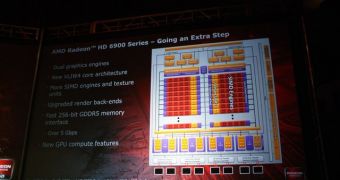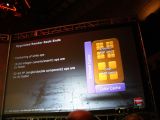With AMD's Radeon HD 6900 graphics card series launch just around the corner, more and more details about the Cayman architecture find their way on the Web, the latest information available showcasing major architectural changes compared to the previous Evergreen cards.
This latest development in the Cayman saga comes to us thanks to the ngohq.com website that posted a series of slides straight from AMD's press deck detailing the Cayman architecture.
Taking a good look at these, uncovers some quite interesting news, as AMD had decided to redesign its unified shader architecture, their structure remaining pretty much unchanged ever since the RV770 days (Radeon HD 4850 and 4870).
What this basically means is that AMD went from a VLIW5 configuration, that used four simple SIMD units and one complex t-unit (transcendental unit) in order to build a stream processing unit, to a VLIW4 configuration that uses four stream units which feature equal capabilities, two of them being assigned with some special functions.
According to AMD's slides, this new approach will offer the same performance as a VLIW5 configuration while reducing the die size with about 10% and simplifying scheduling.
Moving further into the Cayman architecture we also see that AMD choose to go with two separate graphics engines for the HD 6900 series, continuing the work that it began with Barts, the HD 6800 series featuring dual dispatch processors as we have noted in our Radeon HD 6870 review.
This effectively means that Cayman now comes with two tessellation units, so we could see a hefty speed increase in this regard, AMD definitely catching up to Nvidia when it comes down to tessellation power.
Finally, the render back-end has also been changed, Cayman coming with a redesigned Z-Stencil and ROP unit architecture consisting of 128 Z/Stencil ROPs, and 32 color ROPs, up to 2 times faster in16-bit integer operations and two to four times faster in 32-bit floating point operations.
All in all, I would say these design changes will certainly lead to an hefty speed increase, although it's hard to say just how much faster the HD 6900 series will be compared to its predecessor until we don't get a card and put it through our extensive GPU gauntlet. (via techpowerup)

 14 DAY TRIAL //
14 DAY TRIAL // 

